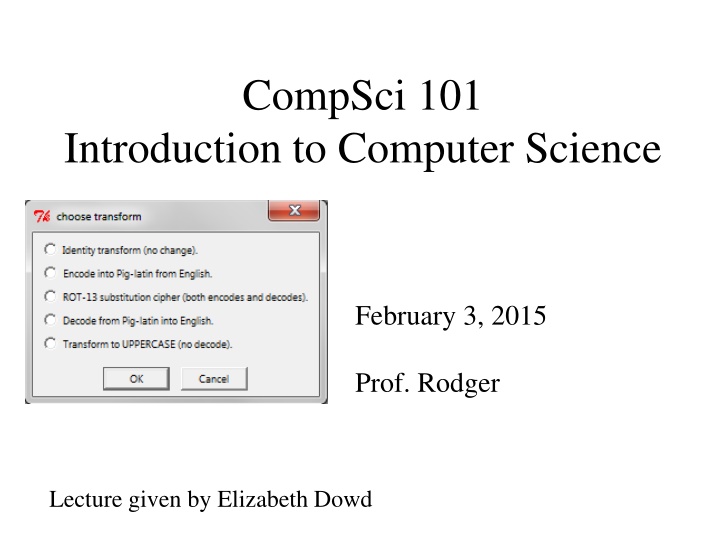
Computer Science Lecture Highlights and Examples on Lists and Decision Making
"Explore key concepts in computer science with a focus on lists, list modification, list processing, and decision-making in Python. Dive into examples and tips shared during the lecture held by Prof. Rodger with images and practical exercises included."
Download Presentation

Please find below an Image/Link to download the presentation.
The content on the website is provided AS IS for your information and personal use only. It may not be sold, licensed, or shared on other websites without obtaining consent from the author. If you encounter any issues during the download, it is possible that the publisher has removed the file from their server.
You are allowed to download the files provided on this website for personal or commercial use, subject to the condition that they are used lawfully. All files are the property of their respective owners.
The content on the website is provided AS IS for your information and personal use only. It may not be sold, licensed, or shared on other websites without obtaining consent from the author.
E N D
Presentation Transcript
CompSci 101 Introduction to Computer Science February 3, 2015 Prof. Rodger Lecture given by Elizabeth Dowd
Announcements Reading RQ08 for next Assignment 3 due today, Asg 4 out APT 3 is due on Thursday Exam 1 Feb 12 try practice test by Feb 10 Accommodations? Reschedule? Fill out forms! Prof Rodger at ACM India conference Finish lecture notes from last time
Lists A list is a collection of objects scores = [99, 78, 91, 84] allAboutMe = [ Mo ,25, 934-1234 ] club=[ Mo , Jo , Po , Flo , Bo ] Lists are mutable use [num] to change a value Lists are indexed starting at 0, or -1 from the end Functions: max, min, len, sum Slice lists [:] compsci101 spring15 4
List Examples scores = [10, 8, 10, 9] print scores scores[2] = 5 print scores print max(scores) print len(scores) print sum(scores) print scores[1:] print scores[1] compsci101 spring15 5
List before/after modification 0 1 2 3 score = [10,8,10,9] 8 10 9 10 0 1 2 3 score [2] = 5 8 10 9 5 10 compsci101 spring15 6
Processing List Items Process all the items in a list, one item at a time Format: for variable in list: block Example: sum = 0 nums = [6, 7, 3, 1, 2] for value in nums: sum = sum + value print sum compsci101 spring15 7
Copying vs aliasing bit.ly/101S15-0203-01 names = [ jo , mo , bo ] club = names team = names[:] names[1] = flo print names print club print team compsci101 spring15 8
Making Decisions True Question ? False compsci101 spring15 9
Making Decisions in Python if condition1: Block of code to do if condition is true elif condition2: Block of code to do if condition1 false, condition2 is true else: Block of code to do if other conditions false Can have many elifs, leave out elif, leave out else compsci101 spring15 10
Making Decisions tools Boolean values: True, False Boolean operators: and, or, not X Y X and Y True False False False X or Y True True True False True True False False True False True False Relational operators: <, <=, >, >= Equality operators: ==, != Look at if examples: miscIf.py compsci101 spring15 11
Compare Ifs bit.ly/101S15-0203-02
More on lists range (1,11) Generates a list of numbers from 1 to 10 Example: for num in range(1,11): print num compsci101 spring15 13
Example answer = 0 for num in range(1,10): if num % 3 == 0: answer = answer + num else: answer = answer + 1 compsci101 spring15 14
Dissect the for loop for VARIABLE in STRUCTURE: BODY Repeat the BODY with the VARIABLE equal to each item in structure
What can the structure be? Variable be? STRUCTURE Variable String character List item in list There are other types of structures we will see
Reading from Files Must open file, close file Easiest way, read one line as a string and then process it inputfile = open( datafile.txt ) for line in inputfile: line = line.strip() do something with line inputfile.close()
Dissect the for loop (again) for VARIABLE in STRUCTURE: BODY inputFile = open( somefile.txt ) for str in inputFile: process str
Writing to File Must open file, close file Open file for writing outfile = open( outputfile.txt , w ) phrases = [ hello there , ] for phr in phrases: outfile.write(phr + \n ) outfile.close() Note: refresh to see the file
Exercise with files Snarf code Uppity.py
